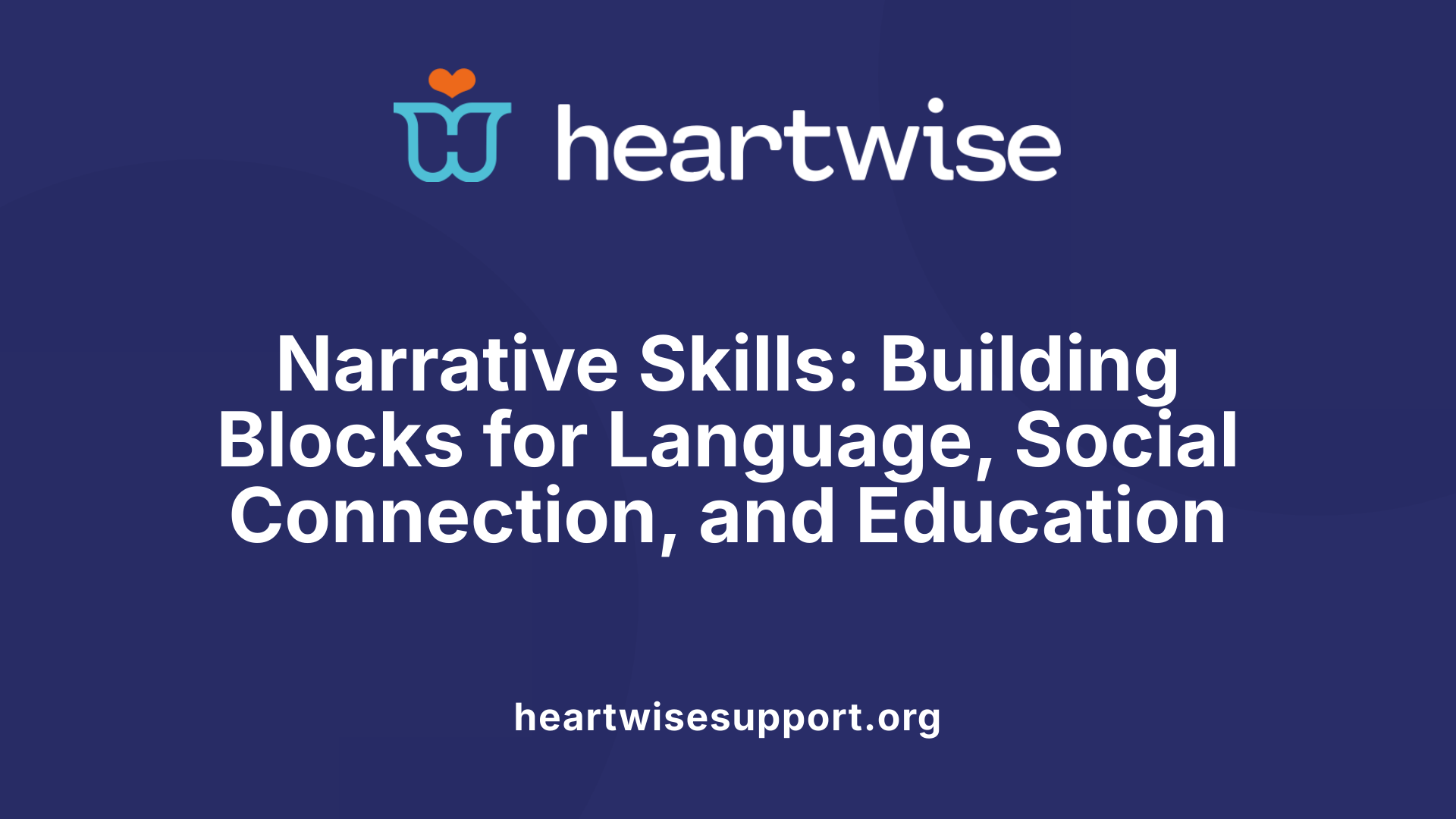The Importance of Narrative and Storytelling Skills in Communication
Narrative and storytelling skills are essential components of effective communication, fostering social connection, cultural understanding, and academic success. Speech therapy offers targeted strategies to develop these skills, supporting children and adults in expressing themselves clearly and confidently.
Understanding the Role of Narrative Skills in Communication Development

Why are narrative and storytelling skills important in communication development?
Narrative skills are fundamental for effective communication because they allow children and adults to share their experiences clearly and meaningfully. These skills help individuals understand how stories are structured, including elements like characters, settings, problems, and resolutions, which is crucial for both understanding and creating stories.
Practicing storytelling enhances language abilities by encouraging attention to details such as sequencing events, recognizing cause-and-effect relationships, and interpreting emotional cues. This meticulous focus on story components strengthens vocabulary, grammar, and overall language comprehension.
Beyond language growth, narrative skills are key to social connection. They enable people to relate personal experiences, share cultural beliefs, and express feelings, fostering stronger bonds with others. Effective storytelling can teach empathy and help in understanding different perspectives.
Stories also play a powerful role in education and influence. They serve as tools for teaching morals, conveying complex ideas, and inspiring others. Emotional engagement through stories facilitates long-lasting understanding and can motivate social and academic development.
Moreover, mastery in narrative skills supports social acceptance and problem-solving. Children who can tell and understand stories tend to be more accepted by peers, receive positive feedback from teachers, and navigate social challenges more effectively. These skills are linked to academic success, especially in reading and writing, and are vital for participating fully in classroom activities and social interactions.
In summary, developing strong narrative and storytelling capabilities equips individuals with valuable tools for personal expression, social interaction, and academic achievement, making them essential components of overall communication development.
Strategies and Activities to Enhance Narrative Skills

What are effective strategies and activities for enhancing narrative and storytelling skills through speech therapy?
Effective ways to boost children's narrative abilities involve a combination of engaging activities and instructional strategies. Visual aids such as story maps, graphic organizers, and picture cards are essential tools. These help children visualize story components like characters, settings, and plot points, supporting better recall and understanding.
Modeling and guided practice play critical roles in learning. When clinicians demonstrate storytelling techniques and gradually allow children to practice with feedback, children can imitate and refine their skills. Promoting rich vocabulary use and descriptive language adds depth to their stories.
Activities such as story retelling, sequencing exercises, and story mapping help children understand story structure in an interactive manner. Digital storytelling platforms and peer sharing encourage motivation, social skills, and creative expression. Incorporating role-playing, improvisation, and pretend play fosters confidence and simulates real-life social and communication contexts.
Involving caregivers and teachers in intervention ensures consistency across environments. Strategies like reading aloud, encouraging children to retell personal stories, and using themed story resources throughout the year reinforce learning. Collaborative activities, such as storytelling with picture prompts and creating original stories, make therapy enjoyable and effective.
Ultimately, these approaches help children develop not just storytelling skills, but also holistic language abilities—improving vocabulary, grammar, memory, and social interaction. The combination of visual supports, active participation, and program collaboration creates a comprehensive environment for nurturing strong narrative skills in young learners.
Approaches and Methods in Narrative Language Intervention

What methods and approaches are used in narrative language intervention within speech therapy?
Narrative language intervention mainly centers on helping children develop the ability to tell and understand stories. Speech-language pathologists use a variety of strategies to promote storytelling skills, including constructing coherent stories, retelling personal experiences, and analyzing story parts. These approaches are designed to enhance children’s overall language abilities, such as vocabulary, grammar, and social pragmatics.
A core component of this method involves teaching story grammar, which includes elements like characters, setting, problems, actions, and resolutions. Clinicians utilize visual aids, such as story icon cards and picture prompts, to make abstract story concepts more concrete and understandable. Using multiple exemplars of the same story structure helps children internalize story schema and promotes generalization of skills.
Interventions often incorporate storytelling activities like story retelling, sequencing exercises, and creating personal or fictional stories. These activities are made engaging through visual supports, immediate feedback, and fun prompts. For example, children may use picture prompts to retell a story, then progress to generating their own stories with scaffolding.
Clinicians tailor interventions to meet individual needs by differentiating tasks and focusing on specific story elements. Strategies like unpacking stories, reconstructing narratives, and incorporating storytelling in everyday routines help children transfer skills across settings. The goal is to support both comprehension and production of complex language, which is crucial for academic success and social communication.
In summary, narrative interventions employ a mix of visual supports, structured story grammar teaching, exemplars, and engaging activities to foster children’s storytelling ability. These evidence-based methods have shown significant positive effects on language development and are widely used in speech therapy practices to help children connect with peers, improve literacy skills, and succeed academically.
Assessment and Goal Setting in Narrative Development
 How do speech therapists assess and set goals for narrative development?
How do speech therapists assess and set goals for narrative development?
Speech-language pathologists use a variety of assessment tools and methods to evaluate a child's narrative skills. Formal assessments such as the Test of Narrative Language, Edmonton Narrative Norms Instrument, and CUBED-3 Narrative Language Measure allow for standardized evaluation of narrative abilities. These tests examine aspects like story comprehension, organization, and storytelling coherence.
In addition to formal tools, therapists often use informal methods such as language sampling, analyzing children's spontaneous speech, and using specific analysis tools like the DYMOND, SLAM cards, and MISL. These approaches help identify strengths and weaknesses in narrative skills, including sequencing, use of story elements, and overall narrative coherence.
Based on assessment results, therapists set targeted, measurable goals. For example, goals might focus on the child's ability to include specific story elements like characters or setting, retell a story with a certain number of elements, or improve the logical sequencing of events. Goals are typically framed following SMART criteria—making them specific, measurable, achievable, relevant, and time-bound.
Collaboration with classroom teachers, parents, and through classroom observations is essential to ensure goals align with curricular standards and daily communication needs. These partnerships help tailor interventions, cross-verify progress, and promote generalization of skills across settings.
Furthermore, therapy goals are individualized, considering each child's current level of ability and personal needs. This personalized approach ensures interventions are relevant and effective, supporting ongoing development in narrative language, which benefits vocabulary, comprehension, and social skills.
Goals and Impact of Narrative Interventions in Speech Therapy
What are the typical goals in narrative speech therapy for children?
In narrative speech therapy, several important goals are targeted to support children's language development. One of the primary objectives is to improve their understanding of story structure. This includes recognizing elements like the beginning, middle, and end, as well as key story components such as characters, settings, problems, and resolutions.
Therapists also focus on enhancing sequencing skills, which allow children to retell stories in a logical, organized manner. This not only helps with comprehension but also builds their ability to narrate their own experiences coherently.
Vocabulary development and expressive language skills are crucial, enabling children to describe characters, actions, and settings effectively. Encouraging children to connect personally to stories is another key aspect, fostering greater engagement and making storytelling more meaningful.
Overall, these goals aim to strengthen both understanding and expressive capabilities, ultimately improving communication, social interaction, and academic success.
Harnessing Narrative Skills for Lifelong Success
Developing strong narrative and storytelling skills through speech therapy not only improves immediate communication abilities but also lays a foundation for lifelong academic and social success. Narrative interventions have been rigorously supported by research, demonstrating their effectiveness in enhancing language skills, literacy, and social-emotional competence. Engaging children with targeted, versatile, and fun activities—ranging from story retelling to digital storytelling—ensures that learning is meaningful and transferable across contexts. Collaboration with educators and families further promotes the generalization of these skills, making narrative development a core component of comprehensive language intervention.
References
- Narrative Intervention: Principles to Practice - ASHA Journals
- 10 Effective Narrative Language Activities for Speech Therapy
- Tips for Helping Your Child Develop Narrative Language Skills
- Narrative Language Goals for Speech Therapy - SLP Now
- Story Grammar Activities to Improve Narrative Skills in Speech
- Language Development Through Narrative Therapy
- Narrative treatment with a side of literacy - The Informed SLP
- Tips for Helping Your Child Develop Narrative Language Skills











